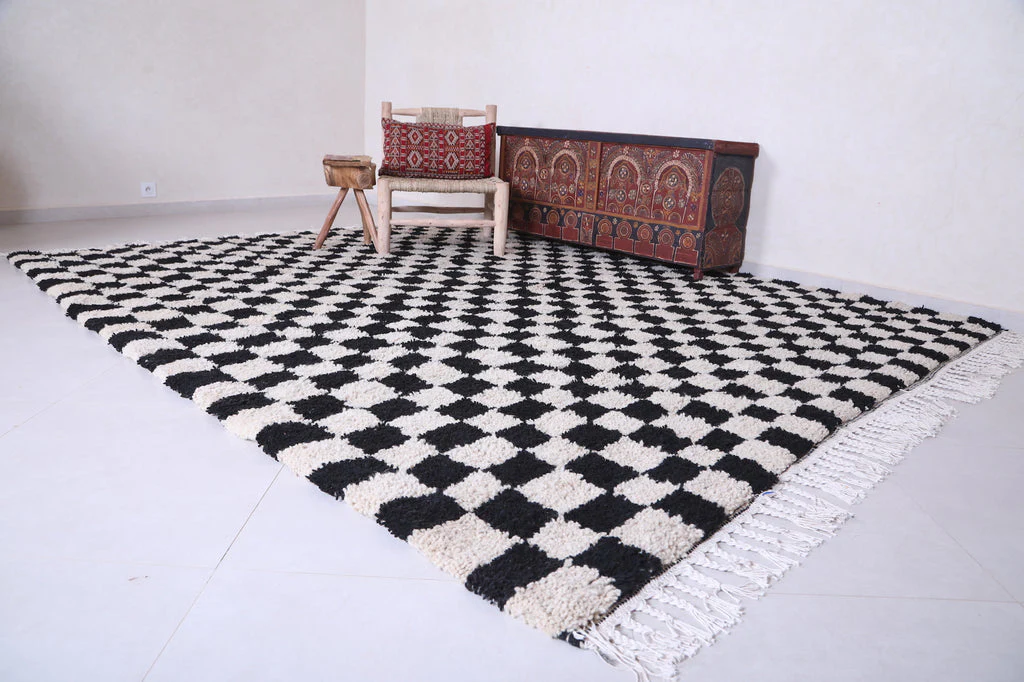Moroccan rugs have profoundly influenced modern interior design by merging rich cultural heritage with contemporary aesthetics. You’ll see their unique textures, bold colors, and geometric patterns creating focal points that bring warmth and character to spaces. These rugs enhance minimalist designs by adding depth while celebrating traditional craftsmanship. Their vibrant earthy tones and warm neutrals inspire color palettes that promote balance and harmony. They fit seamlessly into various styles, from bohemian to modern chic. If you’re curious about how these elements tie into broader design trends, there’s much more to discover.
Historical Significance of Moroccan Rugs
Moroccan style rugs for your home aren’t just beautiful pieces; they’re woven with centuries of history and cultural significance that reflect the traditions of the Berber tribes. When you look at these rugs, you’re not just seeing art; you’re experiencing a rich cultural heritage. Each design and pattern tells a story, often passed down through generations, showcasing the skill of traditional weaving techniques.
The Berber women who create these masterpieces use natural dyes and materials, emphasizing their connection to the land and their ancestors.
Key Characteristics and Styles
These rugs are known for their unique textures, bold colors, and intricate patterns that can instantly elevate any interior design style.
You’ll find that Moroccan rugs often feature geometric shapes and vibrant color palettes, reflecting a rich cultural symbolism.
Each piece tells a story, showcasing the artisan’s skill and the traditional techniques passed down through generations.
The knots and weaves reveal not just artistry but also cultural heritage, making each rug a statement piece in your home.
Whether you opt for a classic Beni Ourain or a colorful Kilim, these rugs embody a blend of tradition and modernity, allowing you to create a warm, inviting atmosphere that speaks to both history and contemporary flair.
Integration Into Modern Aesthetics
Integrating Moroccan rugs into modern aesthetics can effortlessly elevate your space, blending traditional craftsmanship with contemporary design principles.
You can use these rugs to create dynamic texture layering, adding depth and warmth to minimalist settings. Their unique patterns and colors serve as focal points, inviting conversation and interest.
Each rug tells a story, reflecting the rich cultural heritage of Morocco, which can enhance the narrative of your design.
By strategically placing a vibrant rug in a neutral room, you create a stunning contrast that highlights both the rug’s artistry and your modern decor.
This fusion not only enriches your environment but also honors the craftsmanship behind each piece, making your space feel both stylish and meaningful.

Impact on Color Palettes
When you incorporate Moroccan rugs into your space, you’ll notice how they influence your color choices.
The vibrant earthy tones and geometric patterns can inspire a warm, inviting atmosphere, while warm neutrals are becoming increasingly popular.
It’s fascinating to see how these elements come together to create a cohesive design.
Vibrant Earthy Tones
Vibrant earthy tones consistently infuse modern interiors with warmth and a sense of groundedness, making them a popular choice in today’s color palettes.
By incorporating shades like terracotta, deep greens, and warm browns, you create an inviting atmosphere that resonates with color psychology, promoting feelings of stability and comfort.
These hues not only enhance the aesthetic but also reflect a rich cultural heritage, connecting your space to the timeless artistry of Moroccan rugs.
When you choose these colors, you’re not just decorating; you’re embracing a narrative that celebrates both tradition and modernity.
This blend allows you to craft unique environments that feel alive and rooted, transforming any room into a sanctuary that speaks to both history and contemporary style.
Geometric Patterns Influence
Geometric patterns in Moroccan rugs can dramatically shape your color palettes, guiding your choices toward bold contrasts or harmonious blends.
These intricate designs often carry cultural symbolism, reflecting the rich history and identity of Moroccan artisans.
As you incorporate these patterns into your space, you might find yourself drawn to vibrant hues that complement the rug’s geometry, allowing your decor to pop.
The evolution of these patterns over time also influences modern interpretations, blending traditional motifs with contemporary aesthetics.
This fusion invites you to experiment with various colors, from deep jewel tones to soft pastels, creating an inviting yet dynamic atmosphere.
Ultimately, embracing these geometric influences can transform your interior into a visually stunning narrative of culture and creativity.
Warm Neutrals Popularity
As you explore the intricate geometry of Moroccan rugs, you might notice a growing trend toward warm neutrals in modern interiors, which can create a soothing backdrop for these vibrant textiles. This shift is rooted in color psychology, emphasizing calmness and balance, especially in minimalist spaces.
Consider how warm neutrals can enhance the beauty of Moroccan patterns without overwhelming them.
They can also create a sense of unity and harmony throughout your space.
Additionally, warm neutrals foster a cozy atmosphere that invites relaxation and comfort.
Versatility Across Design Trends
Moroccan rugs seamlessly blend with various interior design styles, enhancing both modern and traditional spaces. Their vibrant patterns and textures create a stunning focal point, allowing for a beautiful cultural fusion in your home.
Whether you’re aiming for a minimalist look or a bohemian vibe, these rugs add warmth and character, making them an ideal choice for any design aesthetic. You can use them to express your personal style, reflecting your unique tastes and experiences.
The versatility of Moroccan rugs means they can complement sleek furniture or rustic decor, effortlessly tying together disparate elements. By incorporating these rugs, you’re not just decorating; you’re telling a story that celebrates heritage while embracing contemporary design trends.
Sustainability and Ethical Sourcing
When you choose a Moroccan rug, you’re not just adding style to your space; you’re also supporting artisanal craftsmanship that values tradition.
These rugs are often made from natural materials, ensuring you bring a piece of nature into your home.
Plus, many producers engage in fair trade practices, making your purchase a choice that’s kind to both people and the planet.
Artisanal Craftsmanship Importance
Artisanal craftsmanship plays an essential role in promoting sustainability and ethical sourcing in today’s design landscape. By embracing Moroccan rugs, you’re not just enhancing your space; you’re also honoring cultural heritage and supporting local artisans. Here’s why it’s important:
- Preservation of artisan techniques: Each rug showcases unique skills passed down through generations.
- Sustainable practices: Many artisans use natural dyes and materials, minimizing environmental impact.
- Community support: Purchasing these rugs contributes to the livelihoods of families and communities.
When you choose Moroccan rugs, you’re investing in more than just decor. You’re making a statement about the value of craftsmanship, ethical sourcing, and the importance of preserving traditions in our modern world.
Natural Materials Usage
How do natural materials in Moroccan rugs contribute to sustainability and ethical sourcing?
These rugs often use eco-friendly materials like wool, cotton, and natural dyes, minimizing harmful environmental impacts. By choosing rugs made from these materials, you support a cycle that prioritizes the planet’s health.
The texture contrast in Moroccan rugs adds depth and character to your space while showcasing the beauty of natural fibers. Plus, these materials are typically sourced locally, reducing carbon footprints associated with transportation.
When you incorporate Moroccan rugs into your interior design, you’re not just enhancing aesthetics; you’re also making a conscious choice that aligns with sustainable living. Embracing these rugs reflects a commitment to eco-friendly practices and ethical sourcing in your home.
Fair Trade Practices
Fair trade practices in the production of Moroccan rugs guarantee that artisans receive fair compensation and work in safe conditions, fostering a sustainable community. By choosing fair trade rugs, you support not only the artisans but also the preservation of their cultural heritage.
Here are a few key benefits of fair trade Moroccan rugs:
- Empowerment: Artisans gain financial independence and a voice in their work.
- Quality Craftsmanship: Fair trade assures high-quality materials and techniques are used.
- Community Development: Profits contribute to local projects, improving education and healthcare.
